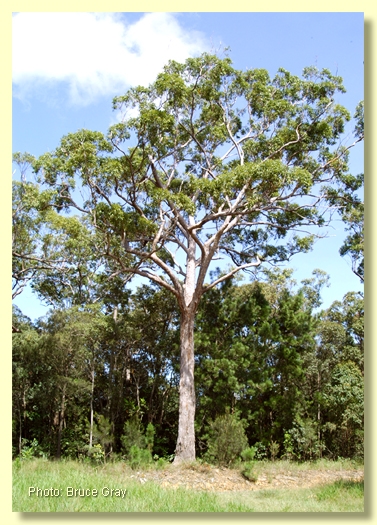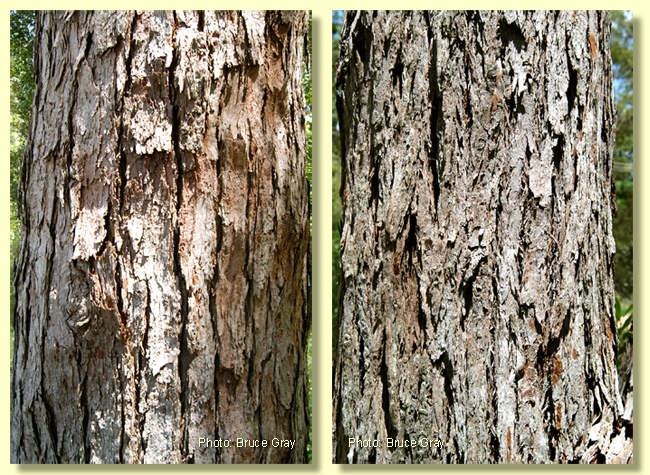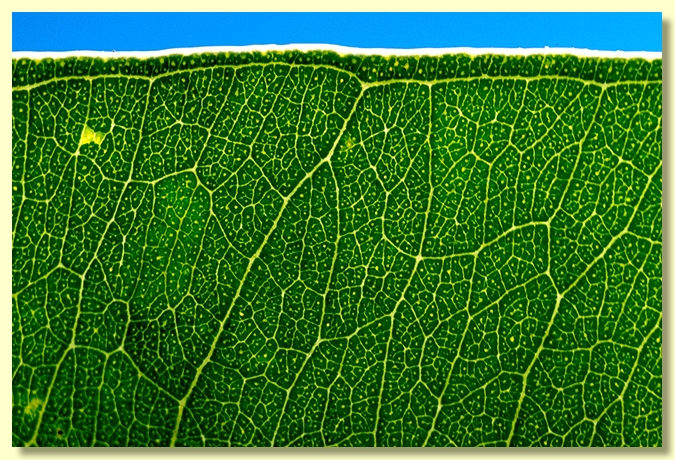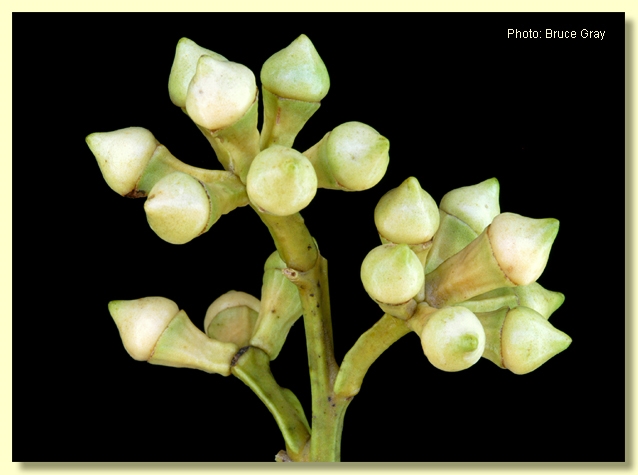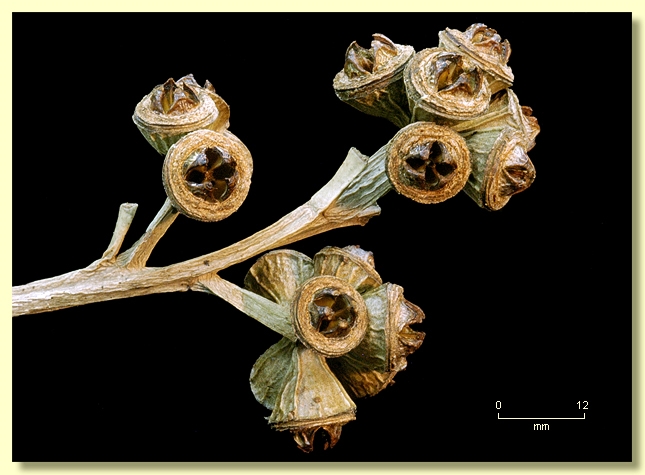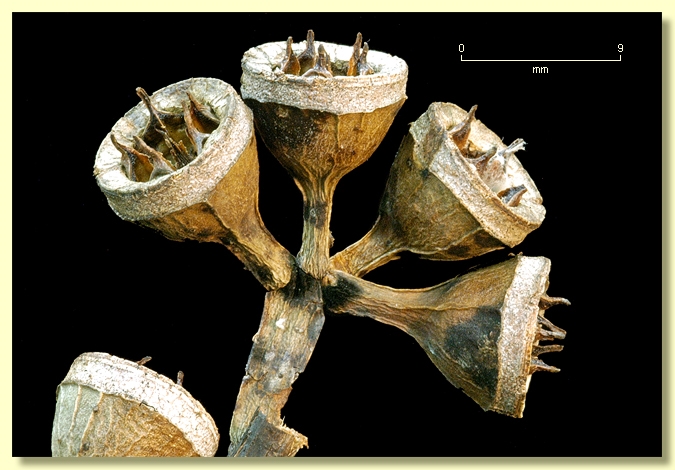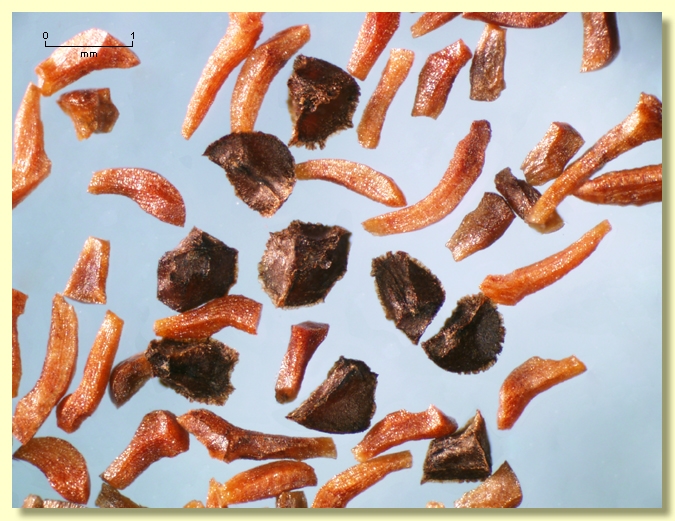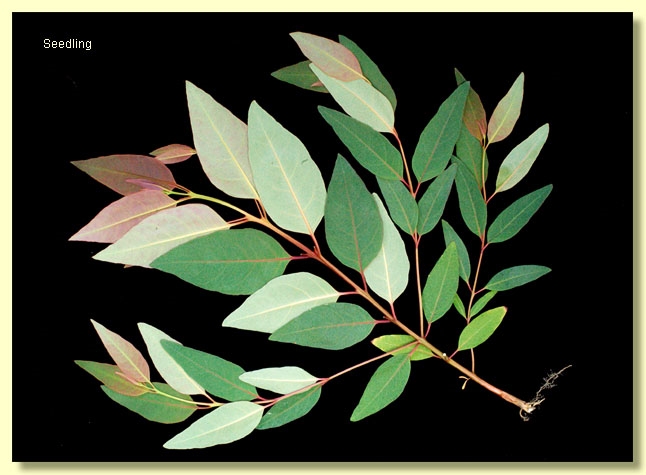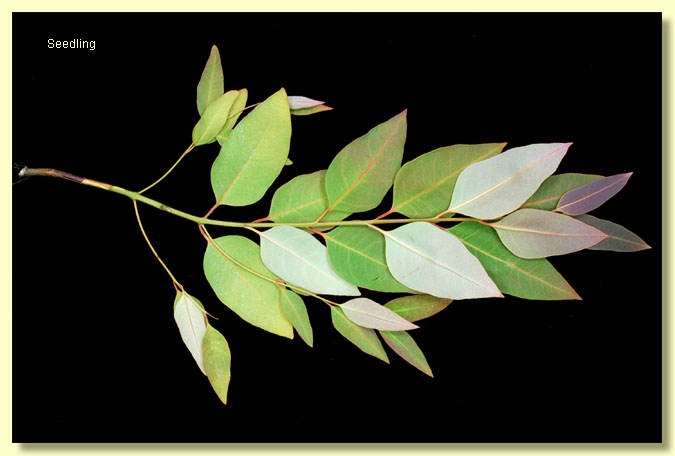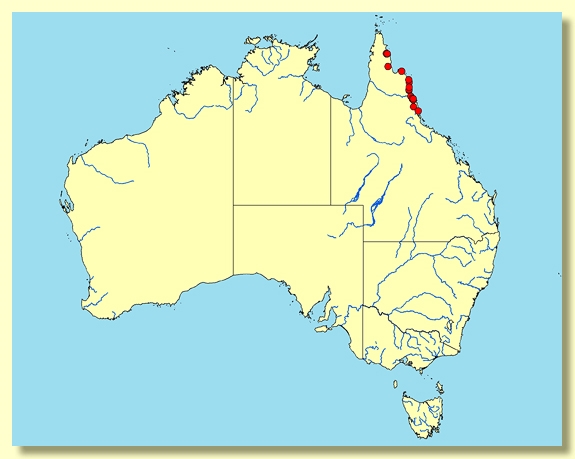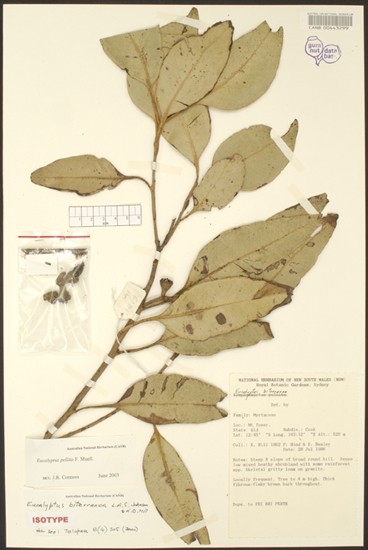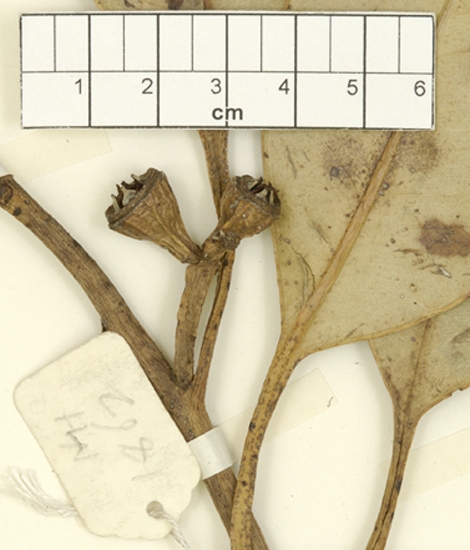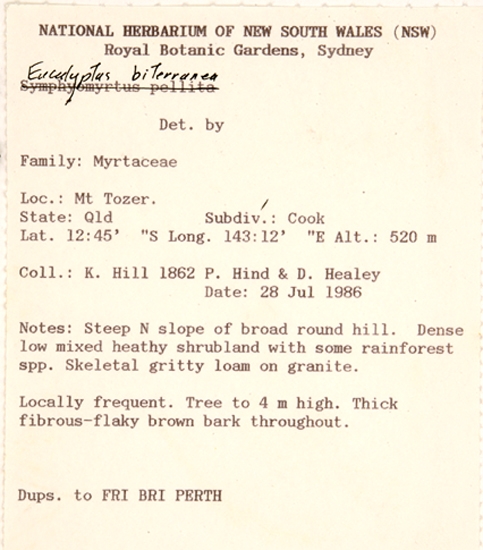Euclid - Online edition
Eucalyptus pellita
Eucalyptus | Symphyomyrtus | Latoangulatae | Annulares
Eucalyptus pellita F.Muell., Fragm. 4: 159 (1864).
Eucalyptus resinifera var. pellita (F.Muell.) F.M.Bailey, Syn. Queensland Fl. 179 (1883). Queensland. Rockingham Bay, J. Dallachy 128, 5 June 1864; lectotype: MEL [MEL1611097]; isolecto: MEL [MEL1611096], probable isolecto: K000279538); fide Bean, A.R., Telopea 12(4): 518 (2010).
Eucalyptus spectabilis F.Muell., Fragm. 5: 45 (1865); E. resinifera var. spectabilis (F.Muell.) Bailey, Syn. Queensland Fl. 179 (1883). T: Rockingham Bay, Qld. 1864, J.Dallachy s.n.; holo: MEL; iso: K.
Eucalyptus biterranea L.A.S.Johnson & K.D.Hill, Telopea 8 (4) 505 (2000). T: Queensland: N slope of Mt Tozer (12°45'S, 143°12'E), K.Hill 1862, P.Hind & D.Healey , 28 July 1986 holo: NSW; iso: BRI, CANB, PERTH.
Tree to 40 m tall. Forming a lignotuber.
Bark rough throughout, fibrous, flaky grey or reddish-brown, sometimes tessellated or platy and held in long strips or slabs.
Juvenile growth (coppice or field seedlings to 50 cm): not seen.
Adult leaves alternate, petiolate, petiole 1.8–3.5 cm long; blade broadly lanceolate to ovate, 10–23 cm long, 3–6.5 cm wide, base usually tapering to petiole, rarely rounded, discolorous, glossy, green, strongly penniveined, densely reticulate, intramarginal vein parallel to and just within margin, oil glands mostly island.
Inflorescence axillary unbranched, peduncles 1.2–3.2 cm long, broadly flattened, buds 7, or rarely more than 7's, pedicellate (pedicels 0.6–0.7 cm long). Mature buds ovoid (1.5–1.6 cm long, 0.9–1 cm wide), smooth, sometimes with longitudinal ribs, scar present (outer operculum shed early in bud development), operculum conical or slightly beaked, often wider at its base than is the hypanthium, stamens inflexed, anthers cuboid, versatile, dorsifixed, dehiscing by longitudinal slits (non-confluent), style long, stigma tapered, locules 4, each with 6 or 8 vertical ovule rows. Flowers white.
Fruit pedicellate (pedicels 0.2–1.3 cm long), cup-shaped to obconical or rarely hemispherical, 0.6–1.1 cm long, 0.8–1.4(1.5) cm wide, sometimes 2-ribbed longitudinally, with prominent vertical, broad, inner operculum scar, disc descending to flat to slightly ascending, valves 4, strongly exserted.
Seeds brown, 1–1.5(2) mm long, pyramidal, dorsal surface smooth, hilum terminal.
Cultivated seedlings (measured at ca node 10): cotyledons bilobed; stems square in cross-section and often winged also; leaves always petiolate, opposite for 4 to 8 nodes then alternate, ovate-lanceolate, 7.5–9.5 cm long, 3.5–4.6 cm wide, base rounded to tapering, margin entire, apex pointed, discolorous, dull, dark green above, paler beneath, with reddish tinge.
Flowering has been recorded in February and October.
Eucalyptus pellita is a medium-sized to tall tree preferring the wetter forests of the east coast of North Queensland from the Abergowrie and Mission Beach area north through the well forested areas of the region to Papua New Guinea. It is found adjacent to rainforest forming wet sclerophyll forest with rainforest species in the understory, but is also known as a smaller tree on areas of impoverished coastal sands growing with more heath-like species. E. pellita is characterised by its thick, rough bark and discolorous leaves with wide-angled side-veins and buds with the base of the operculum normally wider than the hypanthium.
Eucalyptus pellita belongs in Eucalyptus subgenus Symphyomyrtus section Latoangulatae because cotyledons are bilobed, leaves are discolorous and have side-veins at a wide angle to the midrib, buds have two opercula and fruit have exserted valves. Within this section, E. pellita is one of seven species forming series Annulares (the red mahoganies), as it has ovules in six or eight rows, seeds cuboid to pyramidal and bark rough over the trunk. The other six species are E. scias, endemic to New South Wales from the coastal and subcoastal ranges, principally from Batemans Bay north to Cessnock with a disjunct occurrence east of Tenterfield (subsp. apoda); E. urophylla, from Timor and other islands to the north-west of Australia; E. notabilis, scattered in coastal and subcoastal New South Wales and south-eastern Queensland; E. resinifera (with two subspecies) and E. robusta, both widespread in coastal New South Wales and Queensland; and E. botryoides, from coastal eastern Victoria and southern New South Wales. Of these, E. pellita is very closely related to E. scias, E. urophylla and E. notabilis. All four have relatively short fat buds where the operculum is usually wider at the base than the hypanthium. E. pellita differs only marginally fromall three by having slightly larger adult leaves, buds and fruit. E. urophylla differs further by having the valves not prominently exserted as they are in E. pellita. E. resinifera differs by having relatively long narrow buds with an acute operculum, where the base is normally not wider than the hypanthium. E. robusta has cylindrical fruit which normally have the tips of the valves joined across the orifice. (E. pellita fruit are cup-shaped to funnel-shaped to rarely hemispherical.) E. botryoides has sessile to shortly pedicellate oblong buds and cylindrical to barrel-shaped fruit.
A recently described species, E. biterranea, from northern Cape York Penisula and Papua New Guinea, has been placed in synonomy with E. pellita. No significant differences have been observed on the specimens held at the Australian National Herbarium.
The relationship with E. pellita to E. orophylla and E. wetarensis, two recently described taxa from Timor and the Wetar Island, has not been fully examined. E. orophila and E. wetarensis are thought to be very closely related to E. urophylla.
Eucalyptus pellita: Latin pellitus, covered with a skin, most likely referring to the leaves which Mueller described as thick and leathery in his original description - "crassiuscule coriaceis".

